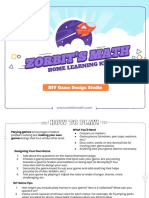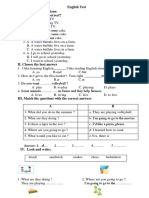Principles of Game Design
John Laird University of Michigan Last changed 9/8/05 [drawn in part from Doug Church]
What is a Game?
How are games different than toys?
Games have rules and goals to be achieved.
Some computer games are really toys
SIMS, Simcity, Nintendogs,
Games can have story, but
Interactive, demands participation
Computer Games
Completely new form of entertainment Completely new worlds to play in Allow players to take on a new persona
� Representing physical objects real or imaginary
Terrain Buildings (exterior and interior walls, floors, ) Game objects (furniture, balls, fluids, weapons, vehicles, ) Animate objects (player, opponents, animals, )
Game Technology: Computational Worlds
Providing dynamics to world
Physics Behavior: AI
Supporting interaction
Graphics Audio: dynamic sound, music, and speech Input devices: speech? Networking
Engineering: Traditional vs. Game
Traditional engineering: High precision Realism Game engineering: High speed Low memory No spiking in resources Scalability O(n) expected Believability Control Low cost development True for graphics, physics, AI, audio, etc. Cheat if dont get caught.
Game Design
Create an experience for the player
Player should have fun, not the designer, programmer or computer
Many different kinds of experiences
Some games are based on a story (dramatic arc, etc). Put the player in his dreams, where he/she is the hero (Sid Meier) Some are puzzles without stories are personification
The player is in some environment
Abstract or representational
The environment has rules of interaction The rules and some criteria for success define a game All managed by the computer
�What Makes for Good Gameplay?
1. Pursuing and achieving goals (challenges) 2. Interactivity 3. Feedback about position relative to goals 4. Interesting choices required to achieve goals 5. Consistency and fairness 6. Avoid repetition
Play testing to ensure that you get it right
This is what is behind Fun (which Reality)
Pursuing and Achieving Goals
Always something to achieve Always achieving something Not too easy or too hard Often at least three levels of goals with rewards
Long-term goal [complete game]
I can conquer the world.
Medium-term goal [10-30 minutes]
I can take over a city.
Short-term goal [seconds to minute]
I can win a battle.
What are levels of goals from different game genres?
Common Goals in Computer Games
Eliminate other players
Action games
Score points
Sports games
Get somewhere first Solve puzzles Gain territory
Strategy games Racing games Adventure games
Improve abilities Develop social relationships
Massively multiplayer games Role-playing games
Play god
Simulations
�Game Interactivity
Players decisions determine success/outcome
At least the player thinks their actions do Avoid decisions that arent related to success of some goal
Player is not just a passive observer
Can be fun, but is different kind of entertainment Always ask: What is the player going to do?
User interface should not get in the way of interactivity
Simple, consistent
Feedback
Feedback at all levels so players
Know where they are Know where they are relative to other players
high score list
Know where they are relative to goal
Dead and dont even know it
Know what they need to achieve Know what is important in the world Can use knowledge to make choices
Game should not be about
how to get information out of the interface how to randomly explore the world (unless that is fun) how to recall what just happened
Gameplay Variety
Must develop & execute strategies/tactics to achieve goals
Applies across all levels of goals
Interesting decisions to achieve goals
Different strategies/tactics Tradeoffs between strategies/tactics: game balance Avoid tedious goals/decisions: micromanagement
Let computer do those Ask if you take out the tedious activity, what decisions are left?
New decisions enabled as game progresses
Few, simple decisions at first, and then more and more Decisions have impact on how game turns out
�Gameplay Consistency and Fairness
There is consistency in the actions and associated outcomes for trying to achieve goals
Must be a reason for failure (or success) Not arbitrary: Players know what to expect and can plan
A pinball game uses pinball physics all the time
Dont solve problems by unique, unlikely actions Dont break suspension of disbelief
Kill self but dead body falls over wall, hits lever to open door
No dead man walking
Fairness
Player thinks they have a fair chance game balance
Can still be plot twists, but must be explainable
Avoid Repetition
Allow user to skip parts already seen
Skip cut scenes Good save system
User must to same thing over and over again
Endless waiting to heal Lining up at spawn points waiting for an item to respawn
Game Design is Hard to Show
A 20 second look doesnt tell you much about a game design Download demos need to play to get it
�Gameplay/Game Design Sins
Poor production
Break the suspension of reality Bad writing, bad voice acting, long load times, saving,
Linear plot/gameplay
Players actions dont affect how the plot progresses
Micromanagement
Player is forced to perform meaningless tasks AI should take care of all the obvious choices
Repetition
Player must do same action over and over again Player must sit through same cut scenes every time they play Have to replay 90% of level to fight boss
Doesnt track users learning curve
Should start easy and get harder as game progresses
Poor game balance
Same strategy always works Trial and error is not fun gameplay
Gameplay/Game Design Sins
Not enough variety
Same graphics, objects, monsters, level design, sounds...
Awkward user interface
Must do lots of mousing to do simple task
Limited feedback
Player is confused about goals Player is confused about current progress to goals: no map
Inconsistency in story
There are not compelling and consistent goals for the player
Dead and you dont even know it
Design Principles (Shigeru Miyamoto)
Start with a simple concept
running, climbing, jumping
Design around the computers limitations
Character wears dungarees so easier to see arms move Wears a hat because dont have to have hair Has mustache because couldnt draw nose and mouth
Minimize the players confusion
What to do should be clear without consulting a manual
The importance of play testing Incorporate a smooth learning curve Accommodate all skill levels
�Sid Meier Game Design
Player should have fun, not designer, programmer, or computer Begin your game with a great first few minutes Great game-play is a stream of interesting decisions that the player must resolve The inverted pyramid of decision making (have few decisions to deal with first, and then let them multiply until the player is totally engrossed Put the player in his dreams, where he or she is the hero
Nokia Series 40 Game Study: Top 10 Usability Recommendations
1. Provide a Clear Menu Structure Use only one main menu, accessible with the left soft key. Keep the menu short. In general, use the left soft key for OK, select, and menu; use the right soft key for cancel and back. 2. Simplicity Is Key If two solutions are equally valid, use the simpler. Make sure each entity in the game is unique, and not easily confused with any other. Provide different game modes only if they are truly different and valuable. 3. Provide Help When Needed Keep help text short. If feasible, scroll text one screen at a time, not one line at a time. Display short text on the screen to explain new items, characters, and situations in the game. Provide a setting to disable in-game help. Provide a graphic representation of which keys are used for which functions. Do not expect players to read help text or force them to do so.
Recommendations 4-7
4. Be Relentlessly Consistent Use the mother tongue of the user. Be consistent with the phone's UI, with game industry conventions, and within the game itself. Use the left soft key for OK, select, and menu; use the right soft key for cancel and back. 5. Don't Waste the User's Time Allow her to skip the introduction. Do not require re-entry of data. Provide shortcuts and reasonable default values. 6. Use Natural Controls Use the 2, 4, 6, and 8 keys for horizontal and vertical movement as well as the arrow keys; use the 1, 3, 7, and 9 keys for diagonal movement, if enabled. Use the 5 key as the action button. Design the game so that it does not lure the user into pressing two keys at once, since many mobile devices (and all Series 40 devices) do not support simultaneous keypresses. 7. Enable Save and Pause Provide a simple save-game feature. Have the game auto-save when the user presses the red phone button - use the destroyApp() method to do this. Provide a pause mode (left soft key, which goes to the game menu); this can be done using the hideNotify() method. If the user quits the game from the pause mode, have the game auto-save.
�Recommendations 8-10
8. Conform to Real-World Expectations For example, when jumping or throwing objects, the flight path should be predictable. There must be no invisible barriers that the player cannot pass or holes that he cannot reach. Do not end the game arbitrarily. Implement a realistic physics model if relevant (for example, racing games). 9. Go Easy on the Sound Provide sound for feedback, but ensure that the game is playable with the sound off, and provide an easy way to turn sound off within the game. No annoying sounds: not too loud, not too high-pitched. Avoid background music, if possible. 10. Implement a High Scores List Tell the user what score he reached before asking for a name; provide the previously entered name as the default. Do not force the user to enter a name; make it optional.
























































































